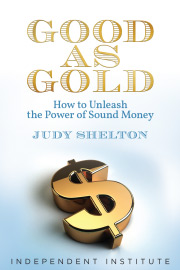Since President Trump announced his intention to nominate Herman Cain and Stephen Moore to serve on the Federal Reserve’s board of governors, mainstream commentators have made a point of dismissing anyone sympathetic to a gold standard as crankish or unqualified.
But it is wholly legitimate, and entirely prudent, to question the infallibility of the Federal Reserve in calibrating the money supply to the needs of the economy. No other government institution had more influence over the creation of money and credit in the lead-up to the devastating 2008 global meltdown. And the Fed’s response to the meltdown may have exacerbated the damage by lowering the incentive for banks to fund private-sector growth.
What began as an emergency decision in the wake of the financial crisis to pay interest to commercial banks on excess reserves has become the Fed’s main mechanism for conducting monetary policy. To raise interest rates, the Fed increases the rate it pays banks to keep their $1.5 trillion in excess reserves—eight times what is required—parked in accounts at Federal Reserve district banks. Rewarding banks for holding excess reserves in sterile depository accounts at the Fed rather than making loans to the public does not help create business or spur job creation.
Meanwhile, for all the talk of a “rules-based” system for international trade, there are no rules when it comes to ensuring a level monetary playing field. The classical gold standard established an international benchmark for currency values, consistent with free-trade principles. Today’s arrangements permit governments to manipulate their currencies to gain an export advantage.
No wonder advocates of pro-growth economic policies feel compelled to question the vaunted status of central bankers, even as currency speculators track their every utterance. Stable money is a prerequisite for genuine economic growth and shared prosperity. The increasing financialization of gross domestic product is unhealthy because the growing size and profitability of the finance sector comes at the expense of the rest of the economy and increases income inequality. When the value of money is fixed, as under a gold standard, economic growth reflects higher levels of productive output.
Fed Gov. Lael Brainard, who was appointed by President Obama, told Bloomberg Television last week that new Trump administration nominees will be expected to put forward “fact-based, intellectually coherent arguments that are based on evidence, that are consistent over time” to participate meaningfully in the Fed’s deliberations.
She’s certainly right that the Fed should act based on the best studies and evidence. It could start with the 2011 paper “Reform of the International Monetary and Financial System,” published by the Bank of England, which analyzed the performance of the gold standard (1870-1913) and the Bretton Woods gold-exchange system (1948-72) relative to current monetary practices. The report concludes that today’s system has performed poorly relative to prior monetary regimes, “with the key failure being the system’s inability to maintain financial stability and minimise the incidence of disruptive sudden changes in global capital flows.” Trade and investment flows are distorted as the world’s major central banks engage in subtle exchange-rate competition.
Discussion might be further enriched by the Obama administration’s 2015 Economic Report of the President, which highlights the growth in middle-class incomes during the Bretton-Woods system of fixed exchange rates. The report describes the period from 1948 to 1973 as the “Age of Shared Growth.” The period was characterized by accelerating labor productivity, falling income inequality, and increased workforce participation. What if post-1973 productivity growth had continued at its pace from the previous 25 years? The report posits that “incomes would have been 58% higher in 2013” and “the median household would have had an additional $30,000 in income.”
The kind of economic growth that increases living standards across all income levels occurs under conditions of monetary and financial stability. Money is meant to serve as a reliable unit of account and store of value across borders and through time. It’s entirely reasonable to ask whether this might be better assured by linking the supply of money and credit to gold or some other reference point as opposed to relying on the judgment of a dozen or so monetary officials meeting eight times a year to set interest rates. A linked system could allow currency convertibility by individuals (as under a gold standard) or foreign central banks (as under Bretton Woods). Either way, it could redress inflationary pressures.
Intellectually fair-minded people should be able to debate the pros and cons of alternative monetary approaches without rancor. What is most important is to avoid monetary mistakes that undermine otherwise positive economic developments. Inflation results when too much money is chasing too few goods. It is not caused by real economic growth, where wages increase to properly compensate people for their higher levels of output achieved through productivity gains.
The Fed’s newfound “patience” in appraising economic and financial developments is welcome—and suitably humble. Central bankers, and their defenders, have proven less than omniscient.









